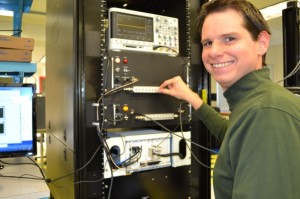
Welcome, Dr Greg Charvat!
- Greg has a ton of great “learn by doing” courses at MIT
- One of the courses is on the MIT Open Courseware site
- He’s worked on research allowing them to “see through walls” with microwaves
- His interest also include radio astronomy and he has built one of his own telescopes!
- He has built an all-tube (23 in total!) stereo system for his home theater
- The coffee can radar is a living project and Greg continues to develop courses around the idea
- The courses also include a phased array DIY radar made of pegboard and wi-fi antennas
- He also has made a high res radar imaging system made from a garage door opener
- In college he got busted trying to record a Buddy Guy show in Chicago with this bootleg tube pre-amp that he built
- He’s into amateur radio equipment, all of which he has built himself
- And for some “down time”, he repairs antique radios
- Oh right, and when he’s not playing at home or playing at work, he’s playing at his new startup, ButterflyNet
If you’re an FPGA enthusiast, looking for a new gig, send Greg an email with some examples of your past work.
In the event you’re not looking for a new gig, check out Greg’s site or catch him on Twitter.
Many thanks to Greg for stopping by and chatting. One of our best guests ever!

Nice show!
Hah, sounds like that FPGA and board design gig is up my ally, except that I’m a bit too much of a newbie at present. Just got code downloading to my first custom FPGA board yesterday actually.
Hmm, regarding making a PCB for that tin can radar, I think I might give it a shot. I wonder if it seems sane to consider something like replacing that VCO module in the bill of materials with a cheaper IC-based VCO like the MAX2750.
Cool, looks like a nice VCO chip.
It may be possible reduce the cost even more by replacing the ~$200 NI DAQ with a ~$10 USB audio CODEC chip like the TI PCM2904. It has built in DACs and ADCs which could generate the tuning voltage for the VCO and sample the filtered mixer output.
It tried making one of these a year ago and I think I ran into problems with isolation between the transmit and receive paths. Splitting some LO off for the mixer with a surface mount directional coupler instead of the power splitter might help that. Possible candidates might be the minicircuits D17I+ or I think richardson RFPD has some too.
Minicircuits sells surface mount mixers for ~$20, or it might be really cool to try an integrated I/Q demodulator/programmable filter/programmable gain amplifier like the TI TRF371125. That might detract from the simplicity a little though..
Wow what a great guy. Loved the show as always.
Awesome interview!
I tried making a PCB for a FMCW radar like the coffee can one a year ago and kinda worked in an anechoic chamber, but I had lots of trouble with isolation/feedback/reflections between the transmit and receive paths. I suspect it may be easier to get good isolation when using minicircuits blocks than on a PCB.
(https://github.com/loxodes/mr_radar/raw/master/mr_radar.jpg is a picture of the radar)
I’m investigating changing it to a pulsed radar that won’t have to deal with simultaneous transmit and receive..
Anyone trying to make a kit out it might want to pay close attention to isolating the TX and RX paths.
Wow, looks great! I don’t envy anyone doing high freq stuff on a PCB. Soon enough (or rather at high enough frequencies) everything looks like a good path for that pesky RF to shoot through!
Hi Guys, great show. I just discovered the existence of your show some weeks ago and I’m working up listening to all previous ones. I’ve arrived at nr. 101 at the moment. As I’m in my car for at least 4 hours a day it’s really great listening to all this interesting stuff. I also enjoy the cultural and lingual differences that pop up sometimes between Americans and Aussies, Keep up the good work !!!
(I’m from The Netherlands by the way….).
Great show as always. Really loved the radar, Lincoln Labs, vacuum tube and ham radio stuff. I visit Lincoln Labs about once a month for my job – awesome place with some really great people. If you want to play with an inexpensive pulsed-Doppler radar, pick up one of the Hot Wheels Radar guns. It’s sadly now discontinued at Toys-R-Us, but I was able to get one on clearance for $8 before they were out of stock. Here’s a link to a video that I did characterizing the pulsed output using a Real Time Spectrum Analyzer.
http://www.youtube.com/watch?v=e4UWqrCwCC0
Of course, not as fun or educational as building one from scratch, but a real cheap way to get something that works that you can use as a starting point…
Best guest (that I’ve heard) so far! I didn’t understand half of what he said, but his passion, and capacity to understand are truly admirable. The thing that I really got from this, is that you don’t have to be a jack of all trades, you can focus on a really small part of the picture and still make a huge difference.
Just found this today
http://www.indiegogo.com/dipper
“a small, affordable and open source UWB radar”
so far its neither open source nor cheap, but they just sarted